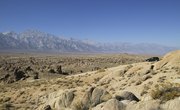What do athlete’s foot, bread yeast and morels have in common? They are all types of fungi.
Kingdom Fungi comprises a diverse group of organisms that includes yeasts, molds and mushrooms. Like plant cells, fungal cells are protected by a cell wall. Unlike plants, fungi cell walls are made of chitin – a material found in insect exoskeletons.
TL;DR (Too Long; Didn't Read)
Fungi are the only organisms that have cell walls made of chitin.
Three Domains of Life
Living things can be classified into three basic domains: Eukarya – the eukaryotes, and Bacteria and Archaea – the prokaryotes. Fungi are eukaryotes, and their cells share similarities with members of the other kingdoms of Domain Eukarya that include plants, animals and protists.
Prokaryotes belong to the domains Archaea and Bacteria. They are single-celled organisms with a simple cellular structure. The following are not eukaryotes:
- Beneficial bacteria, such as those found in the digestive tract.
- Disease-causing bacteria, such as Streptococcus.
- Bacterial decomposers.
- Archaea living in extreme habitats such as ocean vents, volcanoes or areas of concentrated acidity or alkalinity.
Anatomy of a Fungus
Fungi may be single-celled or made of many cells. Some types of fungi, such as yeasts, are single-celled organisms, but most fungi are multicellular organisms that form a network of filaments called hyphae. Filamentous fungi include molds and mushrooms.
These types of fungi grow an intricate web of thread-like structures that remain hidden from view as they spread throughout soil, tissues or decomposing organic material. Typically, only the reproductive, or fruiting, portion of the fungus is visible.
Mushrooms and the fuzzy patches that grow on rotting fruit or old bread are examples of the reproductive portion of fungi. The fruiting body releases spores to allow the fungus to reproduce.
Building Blocks of Cell Walls
Cell walls are not unique to fungi and plants; bacteria and plant-like protists also have cell walls. Chitin is the chemical component of the cell walls of fungi.
Plants and plant-like protists have cell walls composed of cellulose, and bacterial cell walls are made of peptidoglycan. All these cell-wall materials, including chitin, are made from carbohydrate molecules called polysaccharides.
The cell wall protects fungi and allows them to survive unfavorable conditions such as extreme heat, cold and lack of water. Fungi have evolved to become more drought-tolerant thanks to the evolution of more effective cell-wall barriers made of chitin.
Properties of Chitin
Chitin is a flexible material that is insoluble in water. Plants, bacteria and protists are not able to make chitin. However, some animals can produce chitin. Arthropods such as shellfish and insects use chitin to make exoskeletons.
Chitin offers a line of defense against organisms that attempt to feed on fungi. It is difficult for single-celled organisms, such as protists and bacteria, to digest. Some of these protists include amoeba, ciliates and flagellates that live among fungi and are collectively called protozoa.
Chitin-fortified cell walls provide fungi with protection from other organisms that inhabit places where fungi live, such as soil and wood. The chitin in fungal cell walls also helps to prevent viruses from invading the fungi and spreading infection.
Eukaryotic Cell Glycocalyx
The eukaryotic cell’s glycocalyx is a sticky layer that surrounds the cell wall in fungal cells and the cell membrane in animal cells. It allows fungal cells to stick to the substance they are growing in, such as soil particles, decaying organic material or other solid, damp surfaces.
In animals, the glycocalyx allows animal cells to adhere to each other.
References
About the Author
A.P. Mentzer graduated from Rutgers University with degrees in Anthropology and Biological Sciences. She worked as a researcher and analyst in the biotech industry and a science editor for an educational publishing company prior to her career as a freelance writer and editor. Alissa enjoys writing about life science and medical topics, as well as science activities for children
